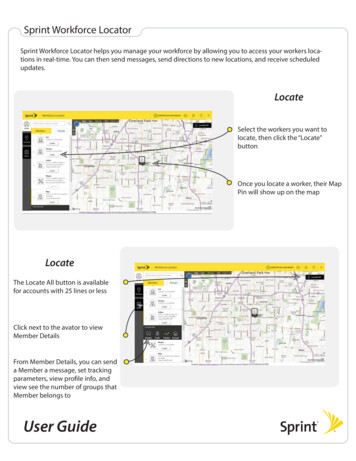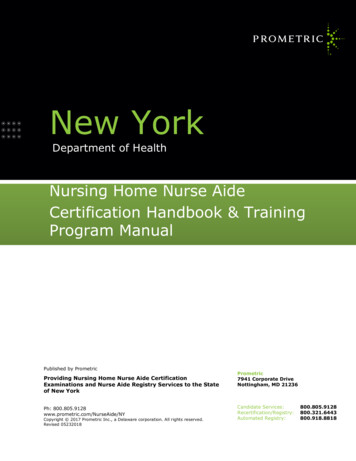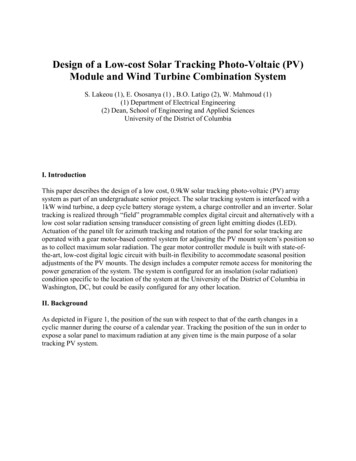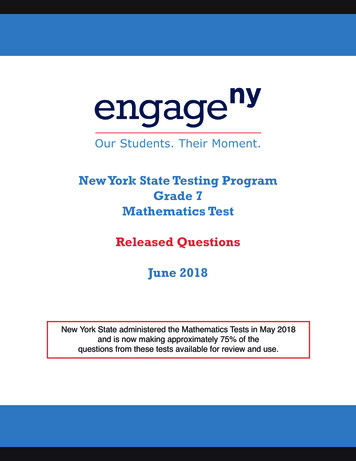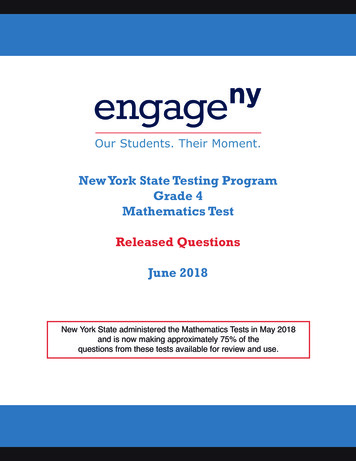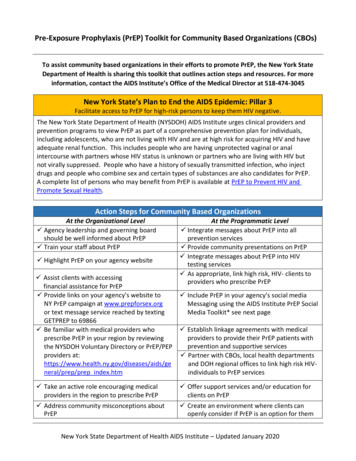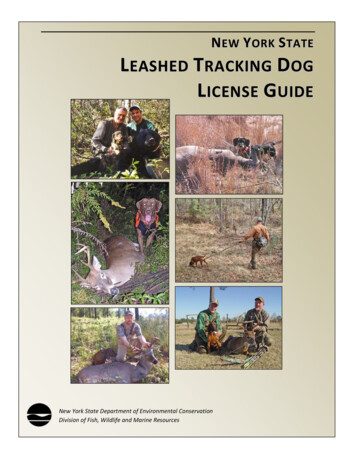
Transcription
NEW YORK STATELEASHED TRACKING DOGLICENSE GUIDENew York State Department of Environmental ConservationDivision of Fish, Wildlife and Marine Resources
AcknowledgementsPrepared byGaye Somogie (Author)Bernadette LaManna (Editor)Natalie Sacco (Design)Photographs courtesy ofJolanta JeanneneySpecial thanks are extended to the following who provided assistance and advice duringthe development of this guide: John Jeanneney (founder of leashed tracking dogprogram in New York State); Jolanta Jeanneney; Andy Bensing; DEC staff Joe Therrien(Special Licenses Program Unit Leader), Steven Hurst (Fish and Wildlife Services BureauChief), Gordon Batcheller (Wildlife Bureau Chief) and Lou Berchielli (retired SeniorWildlife Biologist).Obtaining CopiesCopies can be downloaded at DEC’s website: www.dec.ny.gov/permits/25020.htmlTo obtain a hard copy, please contact DEC’s Special Licenses Unit at518‐402‐8985 or by e‐mail: fwslu@gw.dec.state.ny.us2012, New York State Department of Environmental ConservationJoe Martens, CommissionerKathy Moser, Assistant Commissioner for Natural ResourcesPatricia Riexinger, Director, Division of Fish, Wildlife & Marine ResourcesDoug Stang, Assistant Director, Division of Fish, Wildlife & Marine ResourcesUpdated 3/13
TABLE OF CONTENTSTABLE OF CONTENTS . 1A. HISTORY . 1B. LEASHED TRACKING DOGS. 1C. DOG BREEDS USED . 1D. LICENSING PROCEDURE. 3E. EQUIPMENT . 4F. PARASITES/DISEASES. 4G. TRAINING . 51. Developing Artificial Lines.52. Running a Line . 73. Training Time . 74. Other Training Techniques .8H. TRACKING . 81. White‐tailed Deer Tracking .82. American Black Bear Tracking . 103. Night Tracking .104. Prospective Calls .10I. WEATHER.111. Rain . 112. Snow . 113. Wind . 114. Dry Conditions.11J. SAFETY.11K. BIG GAME .121. White‐tailed Deer .122. American Black Bear .12L. DEER AND BEAR ANATOMY .131. Internal Anatomy White‐Tailed Deer . 132. Internal Anatomy American Black Bear . 13M. SHOTS AND WOUNDS .141. Chest and Lung .142. Frontal Shots .143. Head Shot .144. Neck Shot .145. Gut . 156. Leg Hits .157. Other Wounds and Hair .15N. DISPATCHING AN ANIMAL .16O. SUMMARY.17P. GLOSSARY .18Q. BIBLIOGRAPHY AND ADDITIONAL RESOURCES .19Books . 19Articles . 19Websites .19Suggested Reading for Parasites/Diseases Effecting Dogs . 19R. APPENDIX .20a. Contact Information .20b. Laws and Regulations .20c. Becoming a Licensed Guide . 20
This page is intentionally left blank
A. HISTORYJohn Jeanneney initiated the tracking dog program inNew York State in 1976 when he lived in DutchessCounty. Jeanneney was the first person to receive aresearch permit from DEC to test the possibility of usingdogs to track wounded deer. In 1986, the LeashedTracking Dog Program was signed into law, and, in 1989,the New York State Department of EnvironmentalConservation (DEC) issued the first Leashed Tracking DogLicense (LTD).Since 2008, the use of leashed tracking dogs to trackwounded, injured or dead big game has been legal in 17states. Some of these states followed New York’s lead byinitiating their own tracking programs with similar laws.Other states have adopted their own laws based on theirown hunting history and unique belief systems. In theNortheast, leashed tracking dog programs also exist inMaine, New Hampshire and Vermont. Currently, otherstates are in the process of making it legal to use atracking dog.John Jeanneney, founder of New York State’s leashedtracking dog programB. LEASHED TRACKING DOGSA leashed tracking dog is a dog that is specifically trained to track and locate dead, wounded or injured white‐taileddeer (Odocoileus virginianus) and American black bear (Ursus americanus). Training a dog requires dedication andincludes important techniques, such as working an artificial scent line, training during the day and night, allowingthe dog to become accustomed to other people and tracking deer or bear that have already been located. Once adog is ready for a “real” scent line, it will continue to learn by gaining valuable experience.A handler and a leashed tracking dog can track a deer or bear for a hunter, for special purposes or after motorvehicle/animal accidents. The handler can use their dog to track wounded deer or black bear for a hunter duringthe hunting season, including the 24‐hour period after a hunting season ends. Deer and black bear can be trackedday or night with or without an artificial light. If the handler needs to use a leashed tracking dog for specialpurposes or accidents, it can be done any time of the year using artificial lights if necessary.C. DOG BREEDS USEDSeveral dog breeds have proven to be successful trackers of wounded deer and bear. No single factor makes aparticular breed of dog a dedicated tracker. Success depends on the type of dog, its personality and the training itreceives. When choosing a puppy, the prospective dog handler should consider the scenting abilities of the puppy’sparents, the breeder’s reputation and the puppy’s personality.It is important for a dog to have a good nose for ground scenting. However, other characteristics are also necessaryfor a dog to become a reliable tracker, such as intelligence. An intelligent dog has the ability to stay focused and bepersistent while tracking. A persistent dog will be able to track deer or bear even when a scent trail becomes faintand/or is very long. Intelligent dogs learn from experience.1 N e w Y o r k S t a t e L e a s h e d T r a c k i n g D o g L i c e n s e G u i d e
A tracking dog must learn to ignore distractions, such as other animals and other people, when working. The abilityto ignore distractions can improve with experience. A good tracking dog should have a strong desire to track ananimal or to please its handler. It should be enthusiastic about following a scent trail and be able to demonstrateendurance, physical toughness, stability and courage.A tracking dog must be in good physical condition and be able to track through different types of terrain. A goodtracking dog also may need to swim on occasion, when a scent trail leads to where a deer or bear has entered abody of water. If a dog does not exhibit courage, it may be hard to work with because big game, loud noises orother people may frighten it. Two other desirable traits of a reliable tracking dog are how easily it can be trainedand how responsive it is to the handler’s commands.A beginner dog may exhibit some good tracking abilities and show potential for other positive traits. The handlershould be willing to spend considerable time with a dog and give it a chance to learn and improve. He or she mustdetermine whether the dog has the capability of improving over time and the lasting enthusiasm needed fortracking.Both male and female dogs can become great trackers. However, the handler may notice some differencesbetween males and females. For example, some male dogs may be physically tougher when tracking, while somefemales may be more focused. Most female dogs mature more quickly than their male counterparts. Of course,there are exceptions, and each dog, whether male or female, has its own individual personality and abilities. Afemale with puppies should not be used for tracking until after the puppies have stopped nursing for at least amonth.Successful Breeds of Tracking Dogs Basset houndBavarian mountain bloodhoundBeagleBelgian sheepdogCoonhoundCur breedsDachsbrackeDachshundDrahthaar (wirehaired pointer)Golden retrieverHanoverian bloodhoundJagdtterriers and other terriersLabrador retrieverWachtelhund and other SpanielsWeimaraner2 N e w Y o r k S t a t e L e a s h e d T r a c k i n g D o g L i c e n s e G u i d e
D. LICENSING PROCEDUREOnce the handler has decided to take his/her dog out on a deer or bear call, the procedures described below,along with others outlined in 6 NYCRR Part 176 (see Appendix b), must be followed to “legally” track wounded biggame.1.The handler must contact an environmental conservation officer (ECO) by telephone or in person beforesearching for a wounded animal with their tracking dog. The Division of Law Enforcement (DLE) 24‐hourdispatch number is 1‐877‐457‐5680. For regional DLE telephone numbers during office hours, please seeAppendix a.The following information must be provided to the ECO:a.b.c.d.Name of the licenseeName, address, telephone number and big game license number of the hunter engaging thelicenseeGeneral location of the wounded or injured animalName of the landowner(s) where the search will be conducted2.If the wounded animal is on private property, the landowner must grant permission to track it. If thewounded animal travels to other landowners’ properties while being pursued, the licensee must alsorequest permission from each subsequent landowner before continuing the search.3.The licensee cannot charge a fee for his/her services unless s/he is also a licensed guide. To become alicensed guide, a prospective candidate must be at least 18 years old and pass the exam. For informationon how to become a licensed guide, see Appendix c.4.The licensee must carry a current big game license.5.The licensee must carry a valid LTD license.6.The licensee must use only leashed tracking dogs that have also been licensed and identified as requiredby Article 7 of the New York State Department of Agriculture and Markets Law.7.All tracking dogs must be on a lead attached to the dog’s collar or harness the entire time tracking is inprogress. The lead must be at 12 feet long.8.The licensee is the only person authorized to track a wounded animal. The licensee is not permitted totransfer his/her license to anyone else.3 N e w Y o r k S t a t e L e a s h e d T r a c k i n g D o g L i c e n s e G u i d e
E. EQUIPMENTThe following is a list of necessary and useful equipment and items for every handler. Of course, there is additionalequipment available that a handler may want to have based on his/her personal preferences. Some of theseadditional equipment and items are also listed below. Wide collar or a harnessLeash (stiff mountain‐climbing rope works well as a leash)New York State leashed tracking dog regulations require that all dogs be on a lead that is at least 12 feetlong. Depending on the handler’s personal preference, a longer leash may be more desirable.Light that lasts for four or five hours or a headlight attached to a hatCompass and/or a mapOrange surveyor’s tape or (preferably) biodegradable tape or flaggingLeashed tracking dog licenseBig game licenseWater for handler and dogExtra batteriesFirst‐aid kit for handler and dogAdditional Equipment and Items (Optional) GPS (global positioning system)Hunter orange vest and hatElectronic tracking collarEye protectionEar protectionHunting coat and pants appropriate for different weather conditions, and/or wadersBoots suitable for rough terrain and waterTwo‐way radio and/or cellular phoneWhite tissue for dabbing the ground to check for blood when it is hard to see in the area where a deer orbear was hitF. PARASITES/DISEASESSeveral parasites and diseases can affect dogs. Every dog handler should be knowledgeable and aware of thesymptoms, treatments and vaccinations available to prevent disease and help maintain their dog’s health. If ahandler notices their dog exhibiting any unusual symptoms, the dog should be taken to a veterinarian. Forinformation about the diseases that can afflict a dog and how to prevent it, please refer to the suggested readingsection at the end of this document.4 N e w Y o r k S t a t e L e a s h e d T r a c k i n g D o g L i c e n s e G u i d e
G. TRAININGTraining a puppy or an adult dog to become a good wounded‐deer or wounded‐bear tracker takes time anddedication. Training can begin when a puppy is 7 to 8 weeks old, but a dog of any age can be trained to become aleashed tracking dog if it has potential. However, a very old dog may not have the energy or enthusiasm necessaryfor tracking. In addition, it will not have the time to gain natural experience before retirement.For training and tracking purposes, the prospective leashed tracking dog handler should choose specific words orcommands that s/he finds appropriate for his/her own dog. These should be clear and simple for the dog tounderstand and follow. The handler can use these words or commands to praise, encourage and teach the dogwhen it exhibits appropriate behavior. The handler should stick with the same words for both training andtracking. However, specific words may not be as important as the way they are expressed, such as with excitementor sometimes sternness.The handler can motivate a dog by praising it when, in the proper moment, it exhibits the correct responses whileworking an artificial line, especially when the dog reaches the end of the line. Motivating a dog helps advance itsnatural tracking instincts. Positive reinforcement helps the dog focus on appropriate tracking behaviors. Severepunishment or negative reinforcement is not recommended, except when mild scolding is necessary.Dogs have a strong desire to please the person that they identify as the leader‐the alpha dog. The alpha dog is the“top dog,” the one who dominates everyone else in the pack.” The behavior of recognizing the owner as the alphadog goes back to the behaviors that evolved from their wolf pack ancestry. This has long been thought to be trueand may still carry some validity as far as captive wolves are concerned, but recent research has shed new light onusing the term alpha male when referring to wild wolves. Earlier studies of wolves were based on observations ofcaptive wolves that were unrelated and had been placed together. In the wild, wolf packs usually consist ofparents and their offspring, not a group of unrelated individuals. Therefore, wild wolf parents are moreappropriately called the breeding male and the breeding female or the male parent and the female parent.However, for captive wolves, the term alpha may still appropriately be used.Wild wolves are social creatures and each individual animal exhibits certain behaviors as part of the pack. Forexample, the female wolf tends to the young while the male plays a more important role when it comes toattacking prey. The male and female know what their skills are, and they work together as a team. The same is truefor a tracking dog. A beginner tracking dog learns what is expected of it, what it needs to do as part of a team andwhat the handler’s role is as well. When tracking on a real line, the dog begins to understand that its handler is alsoworking to find the wounded animal.Eventually, these social behaviors help establish a bond between a trainer and a dog. The bond can grow so strongthat a trainer will be able to read the signals that a dog is relaying, and, at the same time, the dog will becomemore attuned to the handler’s commands. A good relationship between a handler and a dog is very important todeveloping a great tracking team.1. Developing Artificial LinesA common technique used to train a dog to track wounded deer is to use an artificial line. An artificial line is adeer‐scent line set up by the handler to imitate a real line. A real line is a scent line of a live, wounded deer.To develop an artificial line, the handler applies deer blood (blood line) making a trail for a dog to track. Inaddition, a deerskin, a deer carcass or a deer part the handler considers appropriate should be placed at theend of the line as a reward. The handler should consider wearing rubber boots while developing an artificialline to avoid confusing a dog with his/her own scent. However, most dogs will instinctively know to followdeer scent rather than a handler’s scent.5 N e w Y o r k S t a t e L e a s h e d T r a c k i n g D o g L i c e n s e G u i d e
After an artificial line has been established, the handler should allow the line to age for only 15 minutes beforea dog is introduced to track the line. In most cases, when a dog is placed in front of an artificial line, it willrealize that it should follow the scent trail. Once a dog has shown an interest in tracking, the artificial line canbe increased in length. When the length of the line increases, it is beneficial to use a few 90‐degree turnswhen setting up an artificial line. This can help a dog learn how to track on a real line that changes directions,rather than continuing in an artificially straight line. The age of the line should also be increased from 15minutes to 1 or 2 hours and then to 4 hours.After a dog has successfully tracked a 4‐hour‐old scent line, the handler can increase the age of the line to 8hours and then to 20 or 24 hours. Increasing the age of an artificial line may teach a dog how to track a “coldline” an old scent trail of a live, wounded deer or bear which they may encounter on real lines. The handlermay also want to consider using less blood on the artificial line to prepare a dog for real lines where there maybe very little blood.Different techniques are used to lay a “blood line” (a trail of deer blood placed on the ground for a dog totrack). The handler must collect deer blood in a container during deer hunting season. It should be kept frozenand then thawed when needed. A half‐pint of blood is usually sufficient for a bloodline. Blood can bedistributed on an artificial line either by using the squeeze‐bottle technique or by using the dabbing technique.A plastic squeeze‐bottle with a spout commonly used in laboratories is an effective way to mark the line. Asimple water bottle with a hole in the cap also works. As the handler walks along the trail, s/he squeezes thebottle to apply a small amount of blood on the ground at about every other step. To apply the blood using thedabbing technique, the handler attaches a small sponge to a stick, dips the sponge into a container of deerblood and then dabs the blood onto the ground at about every second step as well. The squeeze‐bottletechnique usually leaves a larger amount of blood on the ground, while the dabbing technique forms more ofa pattern on the ground.“Scent shoes” can be used as another method for marking anartificial line. These can be made out of wood blocks withboots attached or there are other styles available that canattach to a pair of boots.Whatever kind of scent shoes the handler prefers, s/he canattach deer hooves to them and then drip blood directly ontothe hooves. Alternatively, blood can be placed on the ground,with the handler putting the hooves into it instead. Deerhooves can be kept frozen and used repeatedly.Scent shoes are a good method to use on an artificial line fordogs that have had initial training with blood lines. Theadvantage of this method is that a beginner will pick up otherscents to follow from a deer’s hooves and fur, not just thescent of its blood. This method of training is considered morerealistic in replicating a real line.Scent shoes are an excellent method to usefor creating an artificial scent line6 N e w Y o r k S t a t e L e a s h e d T r a c k i n g D o g L i c e n s e G u i d e
An artificial line can be 10 feet long for a beginner and then increased gradually up to 50 feet. As trainingprogresses, training lines can be up to a quarter‐mile long. The handler should not make an artificial line toolong because it can result in a dog losing interest and motivation in tracking. The handler should consider adog’s tracking abilities and level of interest and judge accordingly.Remember that it can be highly motivating for a dog to find a food reward along with a deerskin at the end ofan artificial line. This motivation reinforces a dog’s desire to track during the next training session.When training a dog to run a line, the handler may consider setting up artificial lines in a few differentlocations. As a dog gains more experience, the handler can make the artificial lines more difficult. Identifyingtrail markers should be placed along the line. These can be as simple as colored clothespins on bushes orbranches along the trail. An alternative is to tie biodegradable orange tape or flagging to branches or leaves.Flags can also be inserted in the ground along the line. The international pattern used for marking a line is across placed at the beginning of the trail, with the time the line was developed written on it. All right‐angleturns should be marked with inverted “L’s” to show the direction the turns take. Finally, another cross isplaced at the end of the line. Be aware that a dog may become accustomed to following the particular trailmarkers used instead of the actual scent on the ground. To eliminate this potential problem, the handlershould place all markers above the dog’s eye level.2. Running a LineWhen a dog begins training on an artificial line that has 90‐degree turns, it is common for it to continuescenting in a straight line, thereby overshooting the turn and losing the scent. Most dogs will realize at somepoint that they have lost the scent trail. The dog then tries to find the scent again by circling back to where itwas lost. This behavior is called working a check. Hopefully, the dog will regain the scent on its own. However,if it has difficulty relocating the scent, it may respond to the handler’s vocal cues and find its way back to thescent trail with appropriate encouragement. If this does not help, mildly scold the dog and bring it back to thespot where it lost the scent trail.The handler should permit the dog to make as many corrections as necessary on its own when working on anartificial line. When a dog tracks on a real line, it cannot rely on the handler for assistance. One way a handlerand a dog can have a more realistic tracking experience is to have someone else set up an artificial line forthem. The handler can also apply his/her own “blind line.” If all of the markers are out of the handler’s sight,then both the handler and the dog must track blindly. This method gives the handler a chance to work withthe dog in a more realistic way and test his or her readiness to be led by the dog.The handler may consider establishing an artificial line in an area populated by live deer. When pursuing awounded deer on a real line, a dog may become distracted by “hot lines,” (scent lines left behind by live deer).Training a dog on an artificial line near “hot lines” should help minimize or eliminate this behavior whentracking on real lines.3. Training TimeThe amount of time the handler spends training a dog on an artificial line depends on both the handler andthe dog. Some handlers have found that training their dog once a week produces good performance resultsand can help maintain a dog’s interest in tracking. Other handlers have found that working a dog several daysa week resulted in poor performance and the dog becoming bored with tracking. This may vary depending onthe handler and the dog involved. As the handler becomes more accustomed to their dog’s behavior, s/he willbe able to figure out the routine that works best for the “tracking team.”It is important to keep in mind that each dog has its own individual personality and abilities. Even an excellenthandler may find that their best training efforts do not produce a good tracking dog. Occasionally a dog withgood gen
Training a dog requires dedication and includes important techniques, such as working an artificial scent line, training during the day and night, allowing the dog to become accustomed to other people and tracking deer or bear that have already . New York State Leashed Trackin
